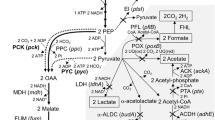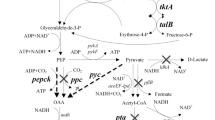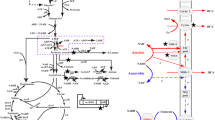Abstract
Succinate is a core biochemical building block; optimizing succinate production from biomass by microbial fermentation is a focus of basic and applied biotechnology research. Lowering pH in anaerobic succinate fermentation culture is a cost-effective and environmentally friendly approach to reducing the use of sub-raw materials such as alkali, which are needed for neutralization. To evaluate the potential of bacteria-based succinate fermentation under weak acidic (pH <6.2) and anaerobic conditions, we characterized the anaerobic metabolism of Enterobacter aerogenes AJ110637, which rapidly assimilates glucose at pH 5.0. Based on the profile of anaerobic products, we constructed single-gene knockout mutants to eliminate the main anaerobic metabolic pathways involved in NADH re-oxidation. These single-gene knockout studies showed that the ethanol synthesis pathway serves as the dominant NADH re-oxidation pathway in this organism. To generate a metabolically engineered strain for succinate production, we eliminated ethanol formation and introduced a heterogeneous carboxylation enzyme, yielding E. aerogenes strain ΔadhE/PCK. The strain produced succinate from glucose with a 60.5 % yield (grams of succinate produced per gram of glucose consumed) at pH <6.2 and anaerobic conditions. Thus, we showed the potential of bacteria-based succinate fermentation under weak acidic conditions.




Similar content being viewed by others
References
Blattner FR, Plunkett G 3rd, Bloch CA, Perna NT, Burland V, Riley M, Collado-Vides J, Glasner JD, Rode CK, Mayhew GF, Gregor J, Davis NW, Kirkpatrick HA, Goeden MA, Rose DJ, Mau B, Shao Y (1997) The complete genome sequence of Escherichia coli K-12. Science 277:1453–1462
Blomqvist K, Nikkola M, Lehtovaara P, Suihko ML, Airaksinen U, Stråby KB, Knowles JK, Penttilä ME (1993) Characterization of the genes of the 2,3-butanediol operons from Klebsiella terrigena and Enterobacter aerogenes. J Bacteriol 175:1392–1404
Cheng KK, Zhao XB, Zeng J, Wu RC, Xu YZ, Liu DH, Zhang JA (2012) Downstream processing of biotechnological produced succinic acid. Appl Microbiol Biotechnol 95:841–850
Datsenko KA, Wanner BL (2000) One-step inactivation of chromosomal genes in Escherichia coli K-12 using PCR products. Proc Natl Acad Sci U S A 97:6640–6645
Foster JW (2004) Escherichia coli acid resistance: tales of an amateur acidophile. Nat Rev Microbiol 2:898–907
Fukui K, Koseki C, Yamamoto Y, Nakamura J, Sasahara A, Yuji R, Hashiguchi K, Usuda Y, Matsui K, Kojima H, Abe K (2011) Identification of succinate exporter in Corynebacterium glutamicum and its physiological roles under anaerobic conditions. J Biotechnol 154:25–34
Ikeda M, Nakagawa S (2003) The Corynebacterium glutamicum genome: features and impacts on biotechnological processes. Appl Microbiol Biotechnol 62:99–109
Ito T, Nakashimada Y, Kakizono T, Nishio N (2004) High-yield production of hydrogen by Enterobacter aerogenes mutants with decreased alpha-acetolactate synthase activity. J Biosci Bioeng 97:227–232
Jantama K, Zhang X, Moore JC, Shanmugam KT, Svoronos SA, Ingram LO (2008) Eliminating side products and increasing succinate yields in engineered strains of Escherichia coli C. Biotechnol Bioeng 101:881–893
Johansen L, Bryn K, Stormer FC (1975) Physiological and biochemical role of the butanediol pathway in Aerobacter (Enterobacter) aerogenes. J Bacteriol 123:1124–1130
Jung M-Y, Ng CY, Song H, Lee J, Oh M-K (2012) Deletion of lactate dehydrogenase in Enterobacter aerogenes to enhance 2,3-butanediol production. Appl Microbiol Biotechnol 95:461–469
Katashkina JI, Hara Y, Golubeva LI, Andreeva IG, Kuvaeva TM, Mashko SV (2009) Use of the lambda Red-recombineering method for genetic engineering of Pantoea ananatis. BMC Mol Biol 10:34
Kim P, Laivenieks M, Vieille C, Zeikus JG (2004) Effect of overexpression of Actinobacillus succinogenes phosphoenolpyruvate carboxykinase on succinate production in Escherichia coli. Appl Environ Microbiol 70:1238–1241
Larsen SH, Stormer FC (1973) Diacetyl (acetoin) reductase from Aerobacter aerogenes. Kinetic mechanism and regulation by acetate of the reversible reduction of acetoin to 2,3-butanediol. Eur J Biochem 34:100–106
Lee SY, Hong SH, Moon SY (2002) In silico metabolic pathway analysis and design: succinic acid production by metabolically engineered Escherichia coli as an example. Genome Inform 13:214–223
Li Q, Wang D, Wu Y, Li W-L, Zhang Y-J, Xing J-M, Su Z-G (2010) One step recovery of succinic acid from fermentation broths by crystallization. Sep Purif Technol 72:294–300
Lu Y, Zhao H, Zhang C, Lai Q, Wu X, Xing X-H (2010) Alteration of hydrogen metabolism of ldh-deleted Enterobacter aerogenes by overexpression of NAD + -dependent formate dehydrogenase. Appl Microbiol Biotechnol 86:255–262
Martínez I, Lee A, Bennett GN, San K-Y (2011) Culture conditions’ impact on succinate production by a high succinate producing Escherichia coli strain. Biotechnol Prog 27:1225–1231
McKinlay JB, Vieille C, Zeikus JG (2007) Prospects for a bio-based succinate industry. Appl Microbiol Biotechnol 76:727–740
McKinlay JB, Laivenieks M, Schindler BD, McKinlay AA, Siddaramappa S, Challacombe JF, Lowry SR, Clum A, Lapidus AL, Burkhart KB, Harkins V, Vieille C (2010) A genomic perspective on the potential of Actinobacillus succinogenes for industrial succinate production. BMC Genomics 11:680
Millard CS, Chao YP, Liao JC, Donnelly MI (1996) Enhanced production of succinic acid by overexpression of phosphoenolpyruvate carboxylase in Escherichia coli. Appl Environ Microbiol 62:1808–1810
Nwachukwu R, Shahbazi A, Wang L, Ibrahim S, Worku M, Schimmel K (2012) Bioconversion of glycerol to ethanol by a mutant Enterobacter aerogenes. AMB Express 2:20
Okino S, Noburyu R, Suda M, Jojima T, Inui M, Yukawa H (2008) An efficient succinic acid production process in a metabolically engineered Corynebacterium glutamicum strain. Appl Microbiol Biotechnol 81:459–464
Otero JM, Cimini D, Patil KR, Poulsen SG, Olsson L, Nielsen J (2013) Industrial systems biology of Saccharomyces cerevisiae enables novel succinic acid cell factory. PLoS ONE 8:e54144
Robles Valderrama E, Ramírez García P, González Arreaga ME, Sáinz Morales MG, Martínez Rodríguez B, Durán Díaz A, Chávez Ramírez D (1999) Application of gas chromatography in the identification of Enterobacter cloacae, Enterobacter aerogenes, and Enterobacter agglomerans. Rev Latinoam Microbiol 41:11–16
Shin SH, Kim S, Kim JY, Lee S, Um Y, Oh M-K, Kim Y-R, Lee J, Yang K-S (2012) Complete genome sequence of Enterobacter aerogenes KCTC 2190. J Bacteriol 194:2373–2374
Thakker C, Martínez I, San K-Y, Bennett GN (2012) Succinate production in Escherichia coli. Biotechnol J 7:213–224
Warnecke T, Gill RT (2005) Organic acid toxicity, tolerance, and production in Escherichia coli biorefining applications. Microb Cell Fact 4:25
Wendisch VF, Bott M, Eikmanns BJ (2006) Metabolic engineering of Escherichia coli and Corynebacterium glutamicum for biotechnological production of organic acids and amino acids. Curr Opin Microbiol 9:268–274
Yuzbashev TV, Yuzbasheva EY, Sobolevskaya TI, Laptev IA, Vybornaya TV, Larina AS, Matsui K, Fukui K, Sineoky SP (2010) Production of succinic acid at low pH by a recombinant strain of the aerobic yeast Yarrowia lipolytica. Biotechnol Bioeng 107:673–682
Zeikus JG, Jain MK, Elankovan P (1999) Biotechnology of succinic acid production and markets for derived industrial products. Appl Microbiol Biotechnol 51:545–552
Zhang C, Lv F-X, Xing X-H (2011) Bioengineering of the Enterobacter aerogenes strain for biohydrogen production. Bioresour Technol 102:8344–8349
Acknowledgments
We thank Yoshihiko Hara and Dr. Akito Chinen for providing experimental materials and Yoko Yamamoto for useful discussion. We also thank Techno Suruga Co., Ltd., for providing technical support for the phenotypic and genetic characterization of AJ110637. This study was funded by Ajinomoto Co. Inc., and no external funds were used.
Author information
Authors and Affiliations
Corresponding author
Electronic supplementary material
Below is the link to the electronic supplementary material.
ESM 1
(PDF 213 kb)
Rights and permissions
About this article
Cite this article
Tajima, Y., Kaida, K., Hayakawa, A. et al. Study of the role of anaerobic metabolism in succinate production by Enterobacter aerogenes . Appl Microbiol Biotechnol 98, 7803–7813 (2014). https://doi.org/10.1007/s00253-014-5884-3
Received:
Revised:
Accepted:
Published:
Issue Date:
DOI: https://doi.org/10.1007/s00253-014-5884-3




